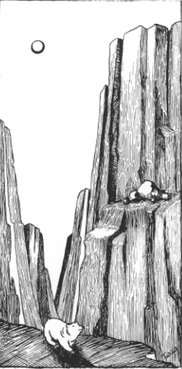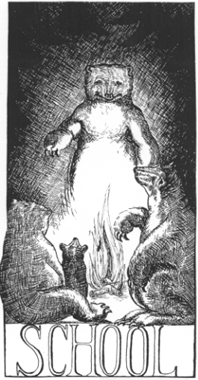Furry Black Bear Cub Once Served as Bruin Mascot; Metal Bear Found
Bear Tracks Fall, 1968
 Every school has a mascot, but most are just in name only. At one time Phoenix Junior college had a real live bear for its mascot.
Every school has a mascot, but most are just in name only. At one time Phoenix Junior college had a real live bear for its mascot.
Unlike the UofA Wildcat, ASU's Lucifer, and NAU's Lumberjack, mere figures, a black bear cub became the living example of school spirit at PJC in 1920. Old-timers relate how the PJC students secured the bruin from a circus that passed through the town.
The bear, almost by instinct, knew when the going was rough on the gridiron. He would rear back on his haunces and bellow.
Over the summer, the cub grew to full size, and the students soon realized that the bear was a potential danger. No one recalls when the bear disappeared, but PJC students soon found another mascot, right across the street from the PUHS grounds.
The Igloo Ice Cream Parlor, an igloo-shaped building across Seventh Street from the school, featured as part of its decoration a plaster bear. From 1925 to 1927, PJC students would "borrow" the bear for an important game, or just for the devilment of it. The owner would mail a notice to the administration that their bear was missing again -- thus giving the students an opportunity to "search" for the bear.
In 1931, student Don Marquess obtained what was to become the first permanent mascot at Phoenix College. The concrete and porcelain monster, weighing over 900 pounds, was used by the Standard Oil Company to advertise "Zerolene" oil.
This "Zeroline" bear was christened Bumstead in 1935 by student Gertrude Mack. Bumstead followed the students when the college moved from the PUHS grounds in 1939, and was placed on a permanent pedestal in the quadrangle in front of the Auditorium (the present Library occupies this location).
Vandals periodically attacked the school's mascot. Bumstead had been tarred and feathered, painted, and believe it or not -- stolen. But in November of 1947, he was decapitated with a sledge hammer; and the American flag and its pole, adjacent to the bear's pedestal, were destroyed with a stick of dynamite. The vandals were never caught.
 The students were angry at the sight of a beheaded Bumstead, but vented their anger on a reconstruction project. Attempts to repair the concrete bear, however, were fruitless.
The students were angry at the sight of a beheaded Bumstead, but vented their anger on a reconstruction project. Attempts to repair the concrete bear, however, were fruitless.
Richard Rogers, a student, and Dr. Virginia Botsford, searched for a replacement bear. They ended their search in Desert Wells, Arizona, where T. J. Dorman helped the duo secure a plaster bear for Phoenix College. Rogers and Eldon Hamblin, another student, made a mold of the new bear and took it to E. M. Adams of the Arizona Iron Works, to be cast in a strong aluminum and steel allow. But both bears vanished in 1949.
In the spring of 1966, over 17 years later, the plaster bear was found hibernating in the rafters of the Administration Building by J. Lee Thompson, dean of the College. The Dean took the bear to the Art Department for a fresh coat of plaster and paint. The finished product, now in his office, is sculptured and painted dark brown with gold highlights.
The metal bear was also found during the spring, but soon returned to his unknown hideaway. Ed Bardo of the Maintenance Department found the metallic replica last semester. The metal beast had become the unofficial mascot of the BEAR TRACKS staff, who have been guarding him against vandals. The Associated Men Students have been trying to raise enough money to purchase a stuffed bear to represent school spirit, but the group has been unable to muster the necessary funds. Plans to display either the plaster or metal bear have collapsed, so even though the school has a mascot, he holds no place of honor in the campus setting.
Part of the Phoenix College website.
Rendered on 8/12/98.